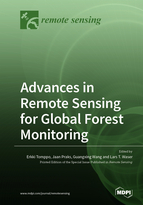Advances in Remote Sensing for Global Forest Monitoring
A special issue of Remote Sensing (ISSN 2072-4292). This special issue belongs to the section "Forest Remote Sensing".
Deadline for manuscript submissions: closed (31 August 2020) | Viewed by 80609
Special Issue Editors
2. Department of Forest Sciences, University of Helsinki, Helsinki, Finland
Interests: forest inventory; forest remote sensing; statistical methods
Special Issues, Collections and Topics in MDPI journals
Interests: small satellite missions; space technology; microwave earth observation; SAR remote sensing; hyperspectral remote sensing
Special Issues, Collections and Topics in MDPI journals
Interests: remote sensing; GIS; spatial statistics and their applications to geography; natural and environmental resources with the specific areas; land use and land cover change detection; sampling design; forest inventory and forest growth modelling; forest carbon sequestration modeling and mapping; environmental dynamic modeling and quality assessment; quality assessment and spatial uncertainty analysis of remote sensing and GIS products
Special Issues, Collections and Topics in MDPI journals
Interests: national forest inventory; spatially estimating forest parameters; tree species; growing stock; change detection; biodiversity; LiDAR; airborne and spaceborne; image-matching; canopy height model; land cover/land use change
Special Issue Information
Dear Colleagues,
The need for temporarily, spatially, and thematically accurate information about forests is increasing because of their role in global carbon balance and sustanaibly social, economic, ecological, and cultural development. Some countries in the world have already had statistically sound forest inventories for 100 years, while others are still lacking, which makes the global information about forest statistics inaccurate.
Globally, forested areas decreased annually in the period of 2010–2015 by 0.08% (3.3 million hectares) (United Nations FAO 2016), although the increases occurred in some regions, for example, in East Asia, Western and Central Asia, Europe, Oceania, and North and Central America, which slowed down the global decrease. Based on the reports from the countries with full-time series, on the other hand, the growing stock has been estimated to increase annually by 0.17% (710 million cubic metres), while the above ground biomass decreased annually by 0.02% (92 million tons).
Remote sensing has been utilized for national forest inventories for many decades, using mainly airborne, but increasingly, spaceborne remote sensing. Remotely sensed data have also been used at global level by FAO for the purpose of comparison and as complementary information, since 1980. Some institutes have attempted to conduct global forest inventories, sometimes providing contradicting information. This implies that remote sensing-based approaches are vulnerable for misclassification and the inaccurate estimation of forest parameters and changes, such as the recognition of temporarily un-stocked forests, forest degradation, and species composition, as well as in strictly following the globally adopted definitions.
The new active remote sensing technology, especially SAR, which is becoming increasingly available, provides new opportunities for large area and global forest inventory, and enough monitoring frequently, in a cost-efficient way. Technically and statistically sound methods are still being developed. This Special Issue invites research papers describing state-of-the-art in the field of remote sensing for forest parameter estimation and change monitoring at national, continental, or global scales. The topics could be, but are not limited to, the following:
- Large area forest inentory and monitoring methods
- Forest area and change estimation with multi-source data
- Forest parameter estimation with multi-source data
- Spatial sampling methods and sampling designs
- Biomass estimation
- Biodiversity
- Forest degradation
- Approaches for assessing uncertainties when using statistically sound inventory methods and multi-source data
- Use of time series with SAR and optical remote sensing data
- SAR interferometry and polarimetry
Prof. Dr. Erkki Tomppo
Assist. Prof. Dr. Jaan Praks
Prof. Dr. Guangxing Wang
Dr. Lars T. Waser
Guest Editors
Manuscript Submission Information
Manuscripts should be submitted online at www.mdpi.com by registering and logging in to this website. Once you are registered, click here to go to the submission form. Manuscripts can be submitted until the deadline. All submissions that pass pre-check are peer-reviewed. Accepted papers will be published continuously in the journal (as soon as accepted) and will be listed together on the special issue website. Research articles, review articles as well as short communications are invited. For planned papers, a title and short abstract (about 100 words) can be sent to the Editorial Office for announcement on this website.
Submitted manuscripts should not have been published previously, nor be under consideration for publication elsewhere (except conference proceedings papers). All manuscripts are thoroughly refereed through a single-blind peer-review process. A guide for authors and other relevant information for submission of manuscripts is available on the Instructions for Authors page. Remote Sensing is an international peer-reviewed open access semimonthly journal published by MDPI.
Please visit the Instructions for Authors page before submitting a manuscript. The Article Processing Charge (APC) for publication in this open access journal is 2700 CHF (Swiss Francs). Submitted papers should be well formatted and use good English. Authors may use MDPI's English editing service prior to publication or during author revisions.
Keywords
- global forest
- large area estimation
- forest inventory
- forest monitoring
- multi-source remote sensing
- Sentinel and Radarsat
- SAR remote sensing: PolSAR, InSAR, PolinSAR
- error and uncertainty
- time series
- open source









